MCU Connection Guide
This guide is used to troubleshoot and resolve issues where the MCU cannot connect to Klipper properly.
Preparation and Notes
- Not Recommended Host Devices: Avoid using devices such as Redmi phones, WiFi dongles, and set-top boxes. These often use customized or modified systems that may fail to properly recognize the MCU.
- Confirm Number of MCUs: Confirm in advance the number of MCUs (e.g., toolboards) you are using. Multiple MCUs may affect the connection.
- Simplify Wiring: It is recommended to temporarily remove all wiring from the mainboard and toolboard except for data cables, retaining only the necessary data connections to eliminate interference.
- Recommended Interface: The Fluidd interface is recommended as it provides a more intuitive display of the MCU connection status.
Step 1: Backup and Reset Configuration
1. Access the Host Interface
Visit the host machine's IP address in a browser (e.g., 192.168.101.179).

2. Locate Configuration File
Enter the web interface and find the configuration options in the left sidebar:
Fluidd Users: Click  | Mainsail Users: Click  |
3. Backup Configuration File
Right-click the printer.cfg file, select Duplicate to copy it, and rename the copy to:
printer_Backup.cfg
Fluidd Example: 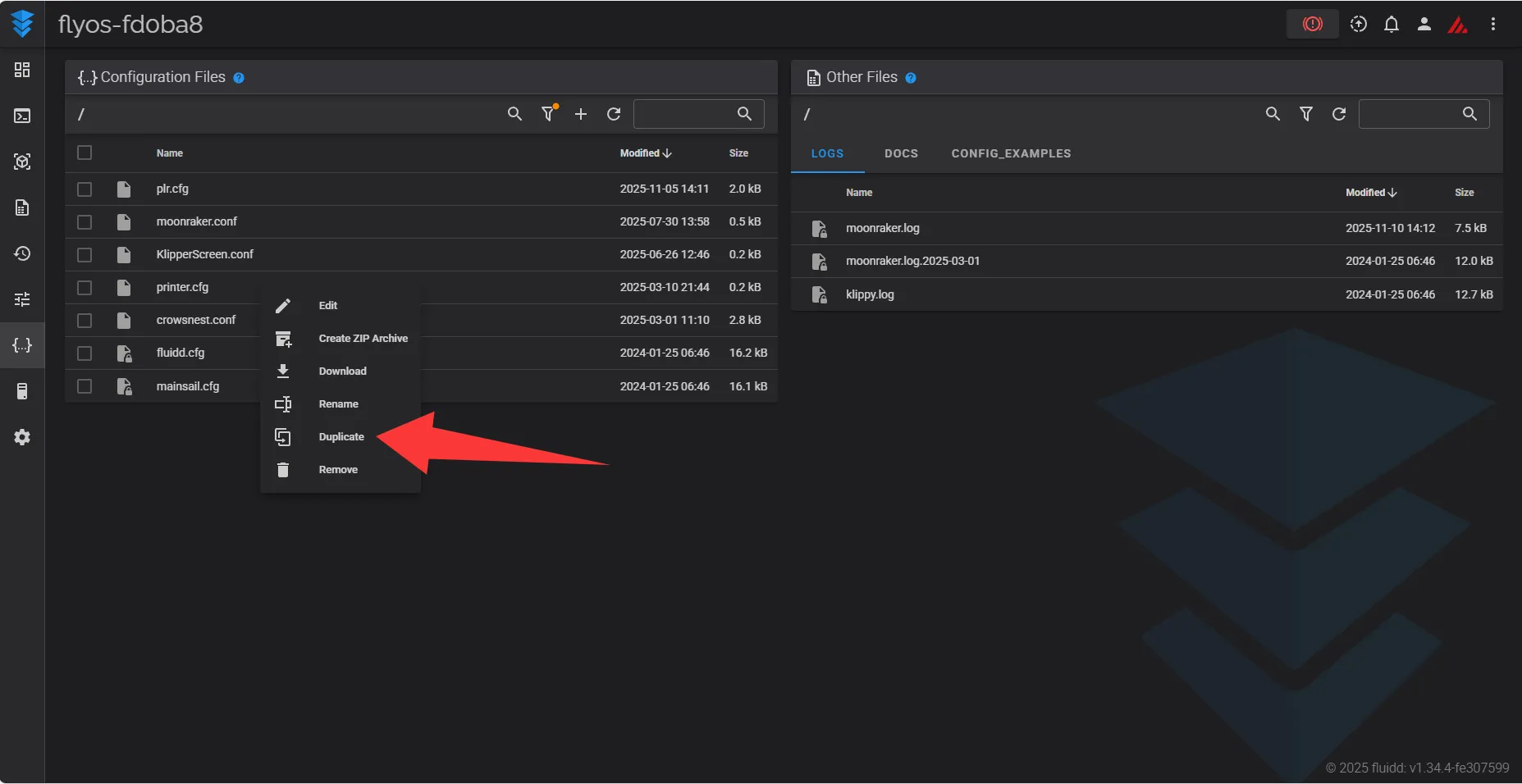 | Mainsail Example: 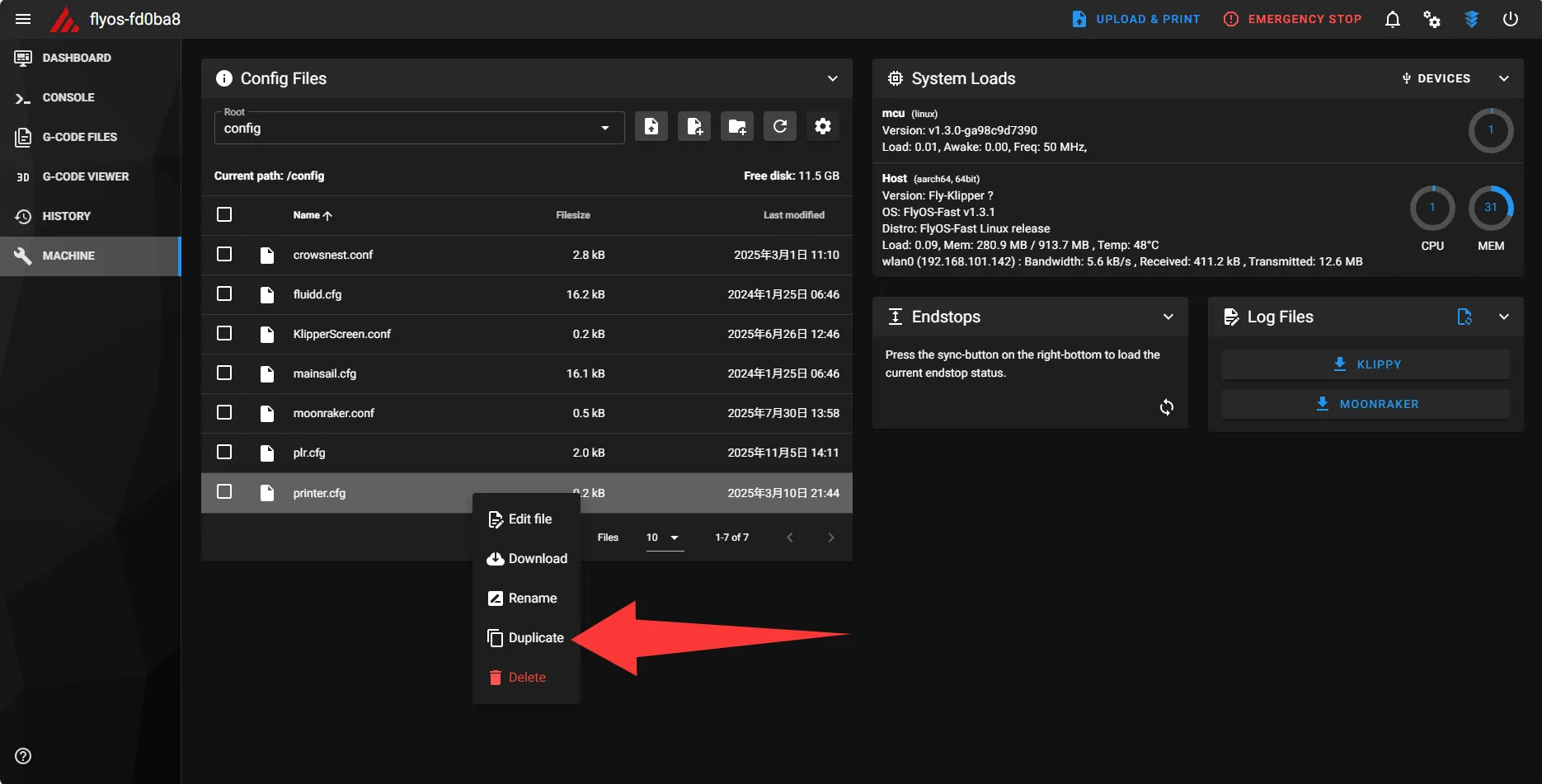 |
4. Reset Configuration File
Reopen printer.cfg, clear all its contents, and paste the following basic configuration:
[mcu]
serial: /tmp/klipper_host_mcu
[printer]
kinematics: none
max_velocity: 200
max_accel: 1000
5. Save and Restart
- Click SAVE & RESTART in the top-right corner. Klipper will save the configuration and restart the service.
- If errors appear, please ignore them for now.
- Next, completely power off all devices (including the host and all MCUs).
- Important: Ensure a complete power-down, or the following steps cannot proceed.
Step 2: Detect Devices and Confirm Firmware Type
Prerequisites
- MCU Order: The first
MCUmust be the mainboard, not a toolboard. - Firmware Type: Confirm that your FLY mainboard firmware is either USB firmware or USB Bridged CAN firmware. This guide does not apply to other types.
- Connection Method: Please connect via SSH first; this operation requires a network connection.
Procedure
-
Run Device Detection
- After successfully connecting via SSH, execute the following command:
lsusb - The system will list all recognized USB devices.
- After successfully connecting via SSH, execute the following command:
-
Handle Command Errors
- If the
lsusbcommand is not found, install it first:sudo apt-get install usbutils - If no devices are displayed after execution, consider changing the host device.
- If the
-
Identify Device Information According to the image below, identify your device in the
lsusboutput: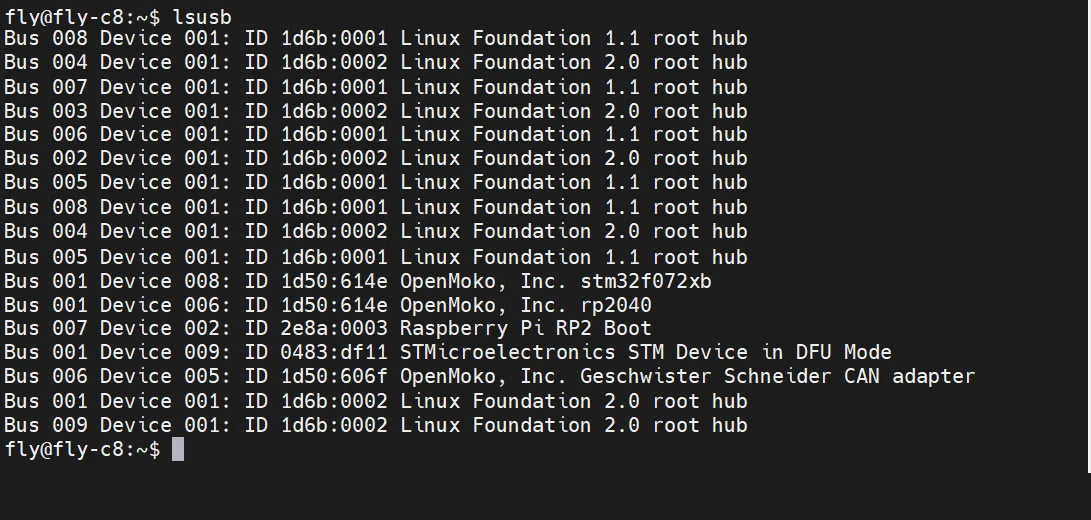

-
Verify Firmware Type
- Based on the firmware you flashed, check the following key information in the
lsusbresults:- USB Firmware: Should display
1d50:614e - USB Bridged CAN Firmware: Should display
1d50:606f - USB Katapult Firmware: Should display
1d50:6177 - RS232 Adapter (used with UTOR or D8/D8PRO mainboards): Should display
1a86:7523(not required when using G2T)
- USB Firmware: Should display
- Based on the firmware you flashed, check the following key information in the
Step 3: Search for Device IDs
Important Notes
- USB ID Search: Only applicable to USB firmware, not CAN or RS232.
- CAN ID Search: Only applicable to CAN bus devices, not USB or RS232.
- RS232 ID Search: Only applicable to RS232 firmware, not USB or CAN.
- RS232 Specificity: RS232 firmware is typically used only for toolboards, not for the main MCU.
Choose Method Based on Firmware Type
USB Firmware Devices Run the following command to search for USB device IDs:
ls /dev/serial/by-id/*
USB Bridged CAN Devices Based on your system type, choose the corresponding command to search for CAN IDs:
- Fly_Armbian or Standard Host
- Fly_FAST System
~/klippy-env/bin/python ~/klipper/scripts/canbus_query.py can0
python ~/klipper/scripts/canbus_query.py can0
RS232 Firmware Devices Run the following command to search for RS232 device paths:
ls /dev/serial/by-path/*
Result Interpretation and Handling
USB ID Search Results
After executing the command, the terminal will display similar device IDs (example shown):
- ✅ Ready to Use: If the ID is labeled as
Klipperafter theusb-field - ⚠️ Firmware Needs Flashing: If the ID is labeled as
katapultafter theusb-field
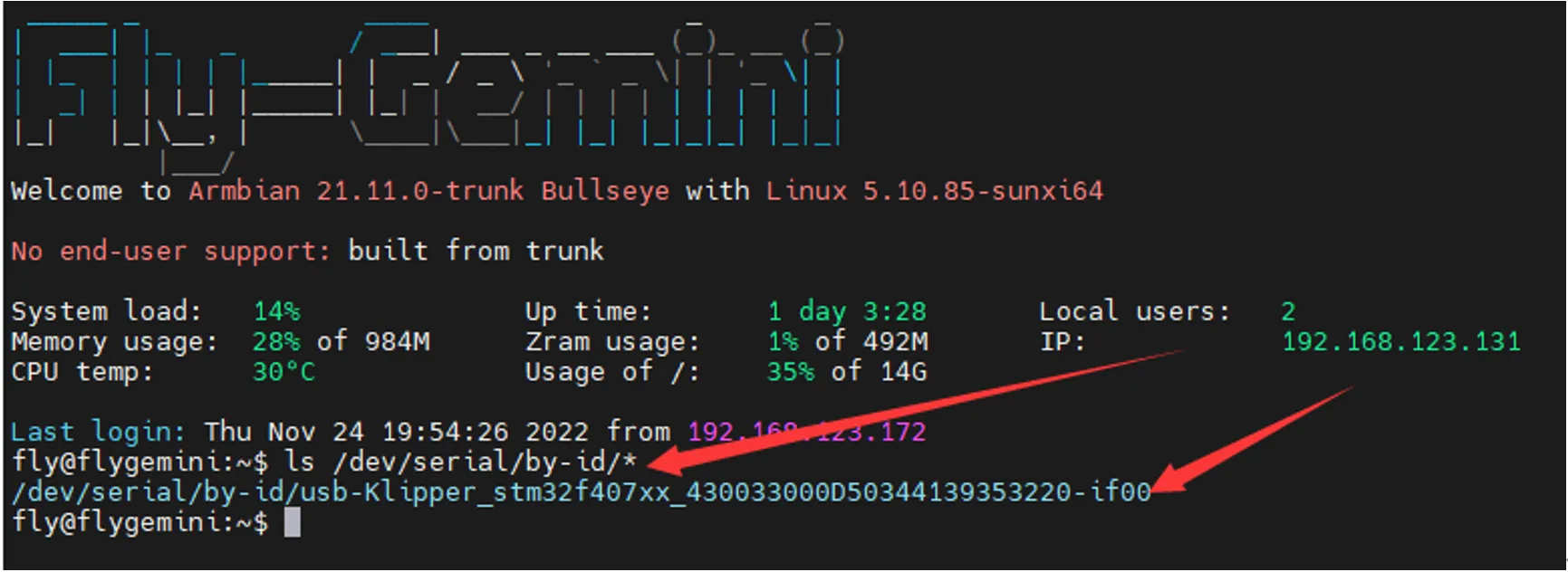
CAN ID Search Results
After executing the command, judge based on actual results:
- ✅ Ready to Use: If the ID is labeled as
Klipperin theApplication:field at the end. - ⚠️ Firmware Needs Flashing: If the ID is labeled as
CANBOOTorKatapultat the end of theApplication:field. - ❌ Device Not Found: If
Total 0 uuids foundis displayed, possible causes include:- Incorrect CAN network configuration
- Mismatched CAN speed (ensure the host, mainboard, and toolboard speeds are consistent)
- The ID is already in use (disable it in the configuration, then power off and restart)

RS232 ID Search Results
After executing the command, the terminal will display the RS232 device path (example shown):
/dev/serial/by-path/platform-3f980000.usb-usb-0:1.2:1.0-port0
RS232 devices must specify the baud rate and restart method in the configuration:
[mcu toolboard]
serial: <Replace with the RS232 device path obtained from the query>
baud: 250000
restart_method: command
Step 4: Configure the Main MCU ID
Before starting the configuration, ensure that the connection between the toolboard and the host or mainboard is disconnected to avoid device identification conflicts.
Reopen the printer.cfg file and locate the serial: /tmp/klipper_host_mcu configuration line in the [mcu] section.
Based on your connection method, refer to the corresponding method below for configuration:
- USB Connection Configuration
- CAN Connection Configuration
Replace /tmp/klipper_host_mcu after serial: with the searched USB ID.
Example Configuration:
# The searched USB ID is:
# /dev/serial/by-id/usb-Klipper_stm32h723xx_12345-if00
# Modify the configuration to:
[mcu]
serial: /dev/serial/by-id/usb-Klipper_stm32h723xx_12345-if00
Replace the serial: /tmp/klipper_host_mcu configuration with canbus_uuid: and fill in the searched CAN ID.
Example Configuration:
# The searched CAN ID is:
# 688e89f0e401
# Modify the configuration to:
[mcu]
canbus_uuid: 688e89f0e401
Save the configuration and restart the Klipper service.
Step 5: Verify Main MCU Connection
After completing the main MCU configuration, verify that the connection is successful:
- Open the Fluidd interface, click
Systemin the left menu. - Check MCU Information: Find the
Micro-Controllerinformation underMcu Information. - Verify MCU Model: Confirm that the displayed model matches the actual MCU model on your mainboard.
- If your MCU is an STM32H723, the
Micro-Controllermust display an H723-related model. - If the display is incorrect or not recognized, check the previous configuration steps.
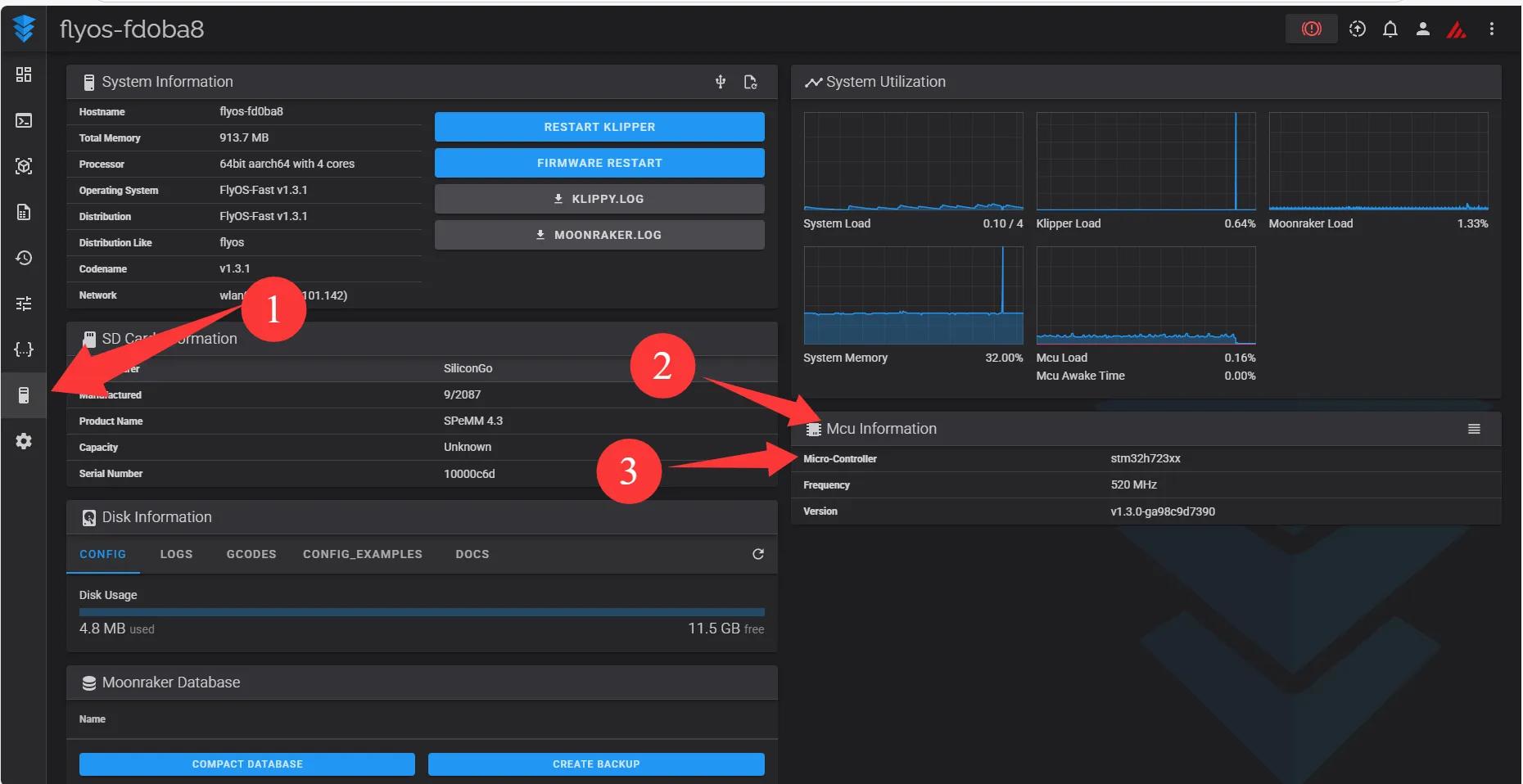
Step 6: Add Toolboard MCUs
After successfully verifying the main MCU, you can add the toolboard:
- Reconnect the Toolboard: Reconnect the toolboard's data cable to the host or mainboard.
- Edit the Configuration File: Add the toolboard configuration at the bottom of the
printer.cfgfile. - Configure the Toolboard ID: Add the corresponding ID in the new configuration section based on the toolboard's firmware type.
The names mcu1, mcu2, etc., in the configuration are only used for temporary differentiation between devices. You can fully customize these names, as long as they remain unique within the configuration file.
Configuration Format:
[mcu mcu1]
# Add the toolboard's ID configuration here
Configuration Examples:
- USB Toolboard
- CAN Toolboard
- RS232 Toolboard
[mcu mcu1]
serial: /dev/serial/by-id/usb-Klipper_stm32f446xx_54321-if00
[mcu mcu1]
canbus_uuid: 688e89f0e402
[mcu mcu1]
serial: /dev/serial/by-path/platform-3f980000.usb-usb-0:1.2:1.0-port0
baud: 250000
restart_method: command
Notes:
- Each MCU must use a unique ID. Ensure the toolboard ID is different from the main MCU and other devices.
- MCU names can be fully customized (e.g.,
toolboard,extruder_mcu, etc.), as long as they remain unique in the configuration. - Be sure to use valid toolboard IDs verified in the previous steps.
- RS232 devices must configure the
baud: 250000andrestart_method: commandparameters. - When configuring multiple toolboards, assign each a different name for easy identification.
After completing the configuration, save and restart the Klipper service.
Step 7: Verify All MCU Connections
After adding the toolboard and restarting Klipper, recheck the connection status of all MCUs:
- Open the Fluidd interface, click
Systemin the left menu. - Check MCU Information: Confirm that all MCUs are correctly recognized under
Mcu Information. - Verify Each MCU Status: Ensure both the main MCU and toolboard show as connected.
- Both the main MCU and all toolboards should appear in the list.
- The connection status for each MCU should be "Connected".
- If any MCU is missing or fails to connect, check its configuration and physical connections.
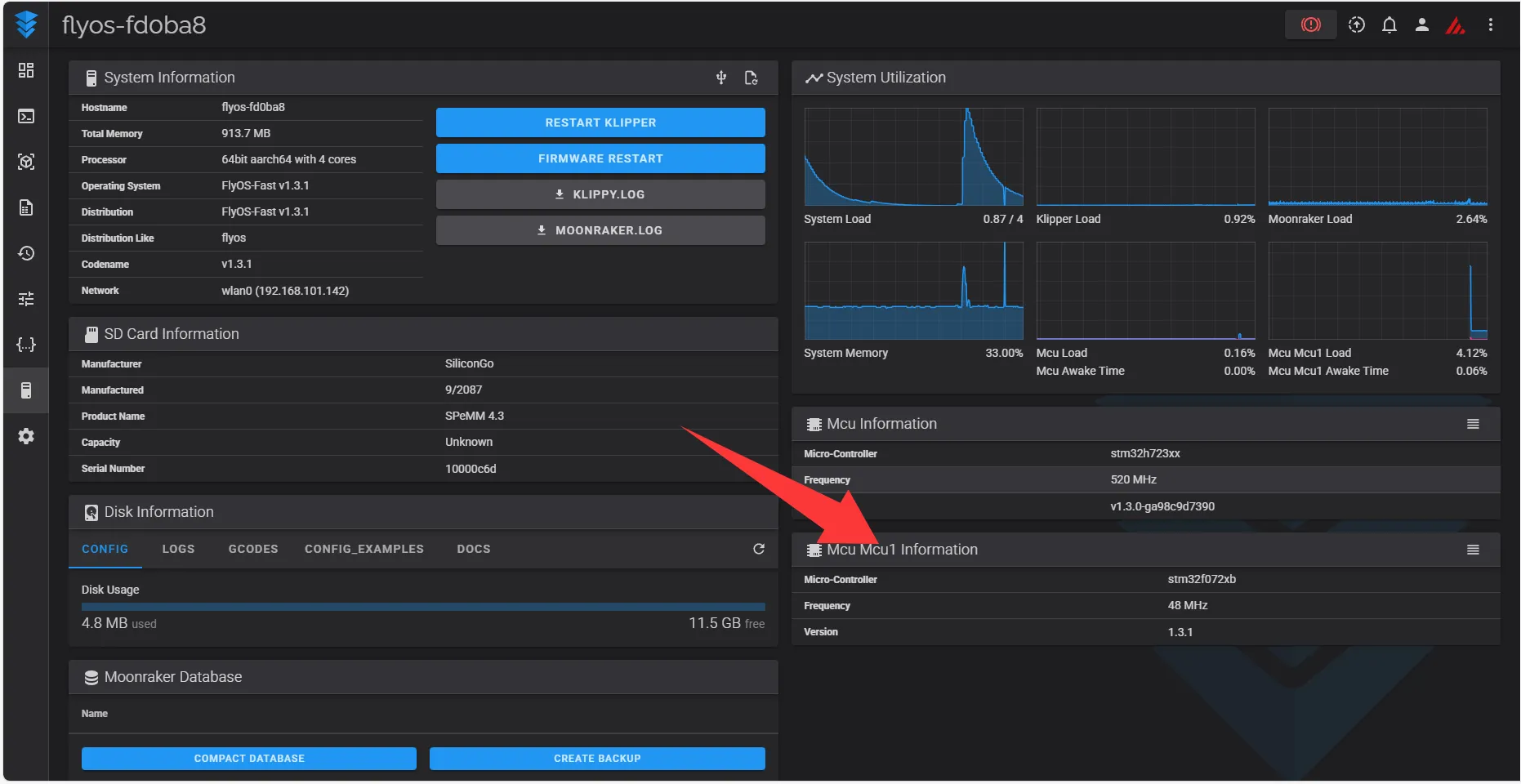
Step 8: Check Firmware Versions
After all MCUs are connected, verify firmware version compatibility:
- Open the Fluidd interface, click
Systemin the left menu. - Check Version Information: Find the
Versionfield underMcu Information. - Verify Version Consistency: Ensure all MCU firmware versions match the Klipper version on the host.
- Custom Compiled Firmware: Except for pre-configured custom devices, all self-compiled firmware must match the Klipper version on the host.
- Fly-FAST System: The firmware version for FAST systems aligns with the system version. The compiled Klipper firmware also matches the system version.
- Consequences of Version Mismatch: Different firmware versions may cause functional issues, communication failures, or system instability.
Verification Points:
- The
Versioninformation for the main MCU and all toolboards should be displayed and consistent. - If versions don't match, re-flash the corresponding firmware.
Step 9: Restore and Update the Configuration File
Once all MCUs are confirmed to be connected properly, restore the original configuration file and update the MCU configurations:
-
Delete the Current Configuration File
- In the configuration file management interface, locate and delete the current
printer.cfgfile.
- In the configuration file management interface, locate and delete the current
-
Restore the Backup Configuration
- Rename the previously backed-up
printer_Backup.cfgfile toprinter.cfg.
- Rename the previously backed-up
-
Update MCU Configuration
- Open the restored
printer.cfgfile. - Locate the original
[mcu]configuration section and update it with the IDs obtained in previous steps:
USB Connection Configuration:
[mcu]
serial: /dev/serial/by-id/usb-Klipper_stm32h723xx_12345-if00
# Replace with the actual main MCU USB ID obtainedCAN Connection Configuration:
[mcu]
canbus_uuid: 688e89f0e401
# Replace with the actual main MCU CAN UUID obtained - Open the restored
-
Update Toolboard Configuration (if applicable)
- Locate the toolboard's
[mcu]section in the configuration file. - Update it with the actual toolboard ID obtained based on the connection method:
USB Toolboard:
[mcu toolboard]
serial: /dev/serial/by-id/usb-Klipper_stm32f446xx_54321-if00CAN Toolboard:
[mcu toolboard]
canbus_uuid: 688e89f0e402RS232 Toolboard:
[mcu toolboard]
serial: /dev/serial/by-path/platform-3f980000.usb-usb-0:1.2:1.0-port0
baud: 250000
restart_method: command - Locate the toolboard's
-
Save and Restart
- After updating all MCU configurations, click SAVE & RESTART to save and restart Klipper.
- Return to the
Systempage and confirm that all MCU connection statuses are normal.
- Ensure you use the correct IDs actually searched during this connection test.
- If multiple toolboards are configured, update each
[mcu]section's ID one by one. - RS232 toolboards must include the
baud: 250000andrestart_method: commandparameters. - After restoring the configuration, existing printer parameters (such as stepper motors, endstops, etc.) will remain unchanged.
At this point, MCU connection troubleshooting and configuration restoration are complete.